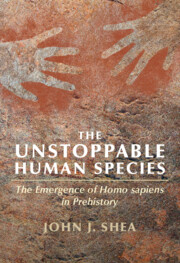93 results
10 - Evolution of Human Reproduction, Ageing and Longevity
-
-
- Book:
- The Biodemography of Ageing and Longevity
- Published online:
- 14 November 2024
- Print publication:
- 21 November 2024, pp 190-216
-
- Chapter
- Export citation
1 - Human Sexuality: The Evolutionary Legacy of Mating, Parenting, and Family Formation
-
-
- Book:
- The Cambridge World History of Sexualities
- Published online:
- 26 April 2024
- Print publication:
- 16 May 2024, pp 1-21
-
- Chapter
- Export citation

The Archaeology of Southern Africa
-
- Published online:
- 15 May 2024
- Print publication:
- 06 June 2024
1 - Human Behavioral Ecology
-
-
- Book:
- Human Behavioral Ecology
- Published online:
- 07 March 2024
- Print publication:
- 14 March 2024, pp 1-19
-
- Chapter
- Export citation
Hunter–gatherer genetics research: Importance and avenues
- Part of
-
- Journal:
- Evolutionary Human Sciences / Volume 6 / 2024
- Published online by Cambridge University Press:
- 15 February 2024, e15
-
- Article
-
- You have access
- Open access
- HTML
- Export citation
Chapter 16 - Evolution and the Human
-
-
- Book:
- Nineteenth-Century Literature in Transition: The 1860s
- Published online:
- 01 February 2024
- Print publication:
- 08 February 2024, pp 289-307
-
- Chapter
- Export citation

The Unstoppable Human Species
- The Emergence of Homo Sapiens in Prehistory
-
- Published online:
- 16 March 2023
- Print publication:
- 23 March 2023
7 - Where Did It All Come From?
- from Part III - Rights and Moral Cognition
-
- Book:
- Mind and Rights
- Published online:
- 09 February 2023
- Print publication:
- 16 February 2023, pp 356-401
-
- Chapter
-
- You have access
- Open access
- HTML
- Export citation
The evolution of peace
-
- Journal:
- Behavioral and Brain Sciences / Volume 47 / 2024
- Published online by Cambridge University Press:
- 16 December 2022, e1
-
- Article
-
- You have access
- HTML
- Export citation
Chapter 11: - The Genus Homo
- from Part I - Introduction to the Scientific Perspective on the Past
-
- Book:
- The Evolution of Everything
- Published online:
- 03 November 2022
- Print publication:
- 24 November 2022, pp 145-158
-
- Chapter
- Export citation
Chapter 10: - Protohumans
- from Part I - Introduction to the Scientific Perspective on the Past
-
- Book:
- The Evolution of Everything
- Published online:
- 03 November 2022
- Print publication:
- 24 November 2022, pp 131-144
-
- Chapter
- Export citation
1 - The Origin of Species
-
- Book:
- Understanding Natural Selection
- Published online:
- 09 November 2022
- Print publication:
- 17 November 2022, pp 1-18
-
- Chapter
- Export citation
4 - The Synthesis
-
- Book:
- Understanding Natural Selection
- Published online:
- 09 November 2022
- Print publication:
- 17 November 2022, pp 56-72
-
- Chapter
- Export citation
7 - Time for a Change?
-
- Book:
- Understanding Natural Selection
- Published online:
- 09 November 2022
- Print publication:
- 17 November 2022, pp 104-126
-
- Chapter
- Export citation
6 - The Positive Case
-
- Book:
- Understanding Natural Selection
- Published online:
- 09 November 2022
- Print publication:
- 17 November 2022, pp 91-103
-
- Chapter
- Export citation
Envoi
-
- Book:
- Understanding Natural Selection
- Published online:
- 09 November 2022
- Print publication:
- 17 November 2022, pp 148-149
-
- Chapter
- Export citation
3 - “The Non-Darwinian Revolution?”
-
- Book:
- Understanding Natural Selection
- Published online:
- 09 November 2022
- Print publication:
- 17 November 2022, pp 36-55
-
- Chapter
- Export citation
2 - Organicism and Mechanism: Rival Root Metaphors
-
- Book:
- Understanding Natural Selection
- Published online:
- 09 November 2022
- Print publication:
- 17 November 2022, pp 19-35
-
- Chapter
- Export citation
5 - Is Natural Selection a Vera Causa?
-
- Book:
- Understanding Natural Selection
- Published online:
- 09 November 2022
- Print publication:
- 17 November 2022, pp 73-90
-
- Chapter
- Export citation
8 - Natural Selection and Its Discontents
-
- Book:
- Understanding Natural Selection
- Published online:
- 09 November 2022
- Print publication:
- 17 November 2022, pp 127-147
-
- Chapter
- Export citation

